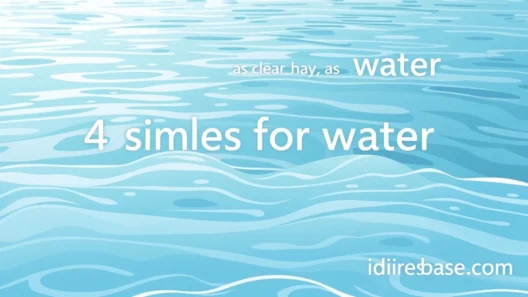Ready to glide through some fantastic comparisons? When we talk about something being "smooth," we're often trying to describe a feeling, a texture, or even a situation that flows effortlessly. But how do you really capture that silky sensation or that flawless transition in words? That's where similes come in! They're like little linguistic magic tricks, helping us paint vivid pictures with comparisons.
In this article, we're going on a delightful journey to explore 40 incredible similes for "smooth." Whether you're a writer looking for the perfect phrase, a speaker wanting to add some sparkle to your descriptions, or just someone who loves the beauty of language, you're in for a treat. Get ready to discover new ways to express that wonderfully smooth feeling!
Why "Smooth" Needs So Many Similes
Think about it: "smooth" can mean so many things! It could be the texture of a polished stone, the gentle flow of a river, the effortless way a dancer moves, or even a conversation that goes off without a hitch. Each of these "smooths" has its own unique flavor. That's why one simple word just isn't enough to capture all its nuances. Similes help us pinpoint exactly what kind of smooth we're talking about. They add depth, imagery, and a touch of poetic flair to our language.
40 Similes for Smooth
Let's dive into our wonderful list! Each simile offers a unique perspective on what "smooth" can feel or look like.
- Smooth as silk: This is a classic for a reason! It evokes a feeling of luxurious, soft texture.
- Smooth as glass: Perfect for describing surfaces that are perfectly flat and reflective.
- Smooth as velvet: Similar to silk, but with a slightly softer, richer feel.
- Smooth as ice: Ideal for surfaces that are slippery and frictionless.
- Smooth as a baby's bottom: A delightful and common comparison for incredibly soft skin.
- Smooth as oil: Think of something flowing easily and without resistance.
- Smooth as a polished stone: For objects that have been worn down to a beautiful, even surface.
- Smooth as a river stone: Similar to a polished stone, but with a natural, organic feel.
- Smooth as still water: Conjures an image of a calm, unruffled surface.
- Smooth as butter: Great for describing something that spreads easily or cuts effortlessly.
- Smooth as a pearl: Evokes a lustrous, unblemished surface.
- Smooth as a cloud: For something incredibly soft, light, and ethereal.
- Smooth as a dancer's glide: Describes graceful, effortless movement.
- Smooth as a well-oiled machine: For something that operates perfectly and efficiently.
- Smooth as a cat's paw: Think of quiet, stealthy, and gentle movement.
- Smooth as a dove's wing: For something soft and delicate to the touch.
- Smooth as a billiard ball: Implies a perfectly round, hard, and unblemished surface.
- Smooth as a mirror: Similar to glass, emphasizing perfect reflection and lack of imperfections.
- Smooth as a snake's skin: For a dry, sleek, and somewhat cool texture.
- Smooth as a whisper: Describes something subtle, gentle, and almost imperceptible.
- Smooth as sand: For a fine, even texture, especially when referring to something that flows.
- Smooth as a lullaby: For a gentle, soothing, and flowing sound or experience.
- Smooth as a breeze: Implies something light, flowing, and without resistance.
- Smooth as a polished apple: For a firm, unblemished, and slightly waxy surface.
- Smooth as a melting snowflake: Captures a delicate, fleeting, and soft transition.
- Smooth as a porcelain doll: For a perfectly formed, flawless, and delicate surface.
- Smooth as a still lake: Similar to still water, emphasizing calmness and reflection.
- Smooth as a fresh coat of paint: For a new, even, and unblemished surface.
- Smooth as an uncreased sheet: For something perfectly flat and without wrinkles.
- Smooth as a freshly shaved face: For skin that is incredibly soft and free of stubble.
- Smooth as a dream: For something that unfolds effortlessly and beautifully.
- Smooth as a river's flow: Emphasizes continuous, unhindered movement.
- Smooth as a perfectly blended smoothie: For something with a consistent, lump-free texture.
- Smooth as a well-practiced speech: For something delivered flawlessly and confidently.
- Smooth as a magician's trick: For something done with such skill it seems effortless.
- Smooth as a pebble worn by the sea: Similar to a river stone, but with the added imagery of ocean waves.
- Smooth as a soft murmur: For a gentle, continuous sound.
- Smooth as a calm sea: For water that is flat and undisturbed.
- Smooth as a freshly ironed shirt: For fabric that is perfectly flat and wrinkle-free.
- Smooth as a perfectly executed plan: For something that goes off without any hitches or problems.
How to Choose the Perfect Simile
With so many options, how do you pick the best one? It's all about context and the specific feeling you want to convey.
Consider the Texture

- Is it soft and luxurious? Think "silk" or "velvet."
- Is it hard and reflective? "Glass" or "mirror" might be your go-to.
- Is it fluid and flowing? "Oil" or "river's flow" could be perfect.
Consider the Movement
- Is it graceful and effortless? "Dancer's glide" or "cat's paw."
- Is it efficient and unhindered? "Well-oiled machine" or "breeze."
Consider the Overall Impression
- Is it comforting and gentle? "Lullaby" or "baby's bottom."
- Is it flawless and perfect? "Polished stone" or "porcelain doll."

By thinking about these aspects, you can choose a simile that not only describes "smooth" but also adds a layer of meaning and imagery to your writing or speech.
FAQs About Similes for Smooth
You've got questions, and we've got answers! Let's dive into some common queries about using these fantastic comparisons.
Q1: What exactly is a simile?
A simile is a figure of speech that directly compares two different things, usually using the words "like" or "as." Its purpose is to make a description more vivid, imaginative, or emphatic. For example, "The road was as smooth as glass" compares the road to glass to emphasize its extreme smoothness.

Q2: What's the difference between a simile and a metaphor?
While both similes and metaphors are figures of speech used for comparison, they do it in slightly different ways. A simile compares two things directly, saying one thing is like or as another (e.g., "Her smile was like sunshine"). A metaphor, on the other hand, states that one thing is another, creating a direct equivalence without "like" or "as" (e.g., "Her smile is sunshine"). Metaphors are generally more forceful and direct.
Q3: Why are similes important in writing?
Similes are incredibly important because they add depth, imagery, and emotion to your writing. They help readers visualize what you're describing, make abstract concepts more concrete, and create a stronger connection with the text. They can transform plain language into something more engaging and memorable. They also show creativity and add a touch of poetic flair.
Q4: Can I create my own similes for "smooth"?
Absolutely! The beauty of language is its flexibility. While our list provides 40 fantastic options, you can definitely create your own. Think about things you associate with smoothness in your daily life. What feels smooth to you? What looks smooth? The more unique and personal your comparison, the more original and impactful your writing will be. Just make sure the comparison is clear and makes sense to your audience.
Q5: Are there any common mistakes to avoid when using similes?
Yes, there are a few!
- Overuse: Don't use too many similes in one place; it can make your writing feel cluttered or forced.
- Clichés: While some similes are classics (like "smooth as silk"), try to find fresh comparisons when possible to keep your writing original.
- Illogical comparisons: Make sure the two things you're comparing actually share a quality that makes the simile effective. Comparing something smooth to something rough wouldn't make sense!
- Unclear meaning: Ensure your simile clearly conveys the specific aspect of "smoothness" you're trying to highlight.
Key Takeaways
- "Smooth" is versatile: The word "smooth" can describe textures, movements, processes, and even abstract concepts.
- Similes add depth: Using similes helps you specify what kind of smooth you're talking about, adding vivid imagery and meaning.
- Options galore: There are countless ways to describe "smooth," from the classic "smooth as silk" to the more unique "smooth as a well-oiled machine."
- Context is key: Choose your simile based on the specific texture, movement, or overall impression you want to convey.
- Enhance your writing: Similes are powerful tools for making your descriptions more engaging, memorable, and impactful.
- Be creative: Don't be afraid to invent your own similes to add a unique touch to your language!
We hope this exploration of "smooth" similes has given you a fresh perspective and a richer vocabulary. Now go forth and make your words glide effortlessly across the page, as smooth as a dancer's glide! What's your favorite simile for smooth? Share your thoughts and let's keep the conversation flowing!






